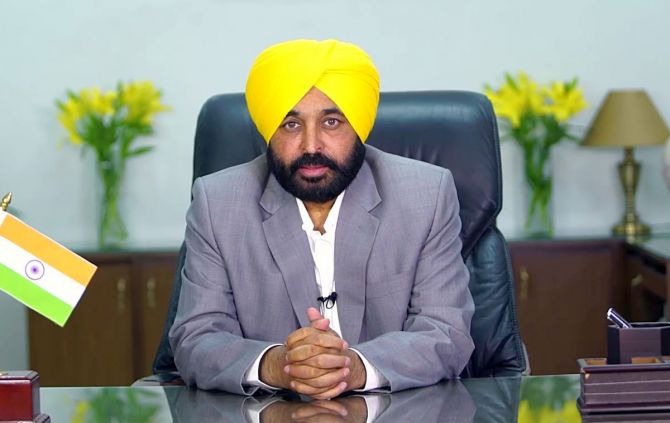Given the sheer size of the state, achieving a similar turnaround in Punjab as promised could be a different ball game altogether, reports Sai Manish.

Punjab’s new chief minister Bhagwant Mann decided to get to work on the day of his swearing-in, saying there was little time to waste and many promises made by his boss, Arvind Kejriwal, to keep.
Mann has an arduous if not an impossible task to fulfil many of the dreams peddled by Kejriwal to Punjab’s masses in the run-up to the elections.
That’s because Punjab isn’t Delhi, whose model is being sought to be replicated in the state.
Punjab’s staggering debt of Rs 2.6 trillion is equivalent to half its gross state domestic product (GSDP).
In revenue-surplus Delhi, the state debt accounts for just 2 per cent of its GDP.
Every year Punjab spends 41 per cent of its revenues simply repaying its loans and the interest on it.
Delhi spends just 10 per cent of its revenues servicing its debts.
Punjab has 10 million more mouths to feed and a significantly smaller taxpayer base to tap into than Delhi has.
The consequences are apparent.
Punjab spends just 11 per cent of its revenues on education -- almost half that of Delhi and significantly lower than that of most other states in India.
It spends just about 4 per cent of its budget on medical and public health infrastructure -- one-third of that of Delhi and lower than the national average.
Punjab allocates more money for its notoriously inefficient police force than it spends on providing medical facilities to its residents.
No wonder then, the first thing Mann did after being elected was announce the withdrawal of police security to all the erstwhile and new MLAs.
Punjab is a state notorious for the police “gunman” culture, where every one, from top cops to bureaucrats and politicians, is assigned a number of police persons for escort duties.
Having a couple of police “Gypsys and gunmen” in tow at all times is seen as having reached the pinnacle of the power pyramid in Punjabi society.
Punjab’s slide into financial hell and its debilitated state today started in the post-terrorism era.
In the late 1990s, the freebie culture, best exemplified by free electricity to the state’s farmers, proliferated.
Much of Punjab’s debt woes are attributable to losses and loans of its state electricity discom.
Along with the freebie culture, the endemic corruption of the state’s multiple mafias, as highlighted by AAP during the election campaign, spread with impunity.
“The money Punjab forgoes and the precious revenue that leaks due to the state’s entrenched interests who revel in non-compliance with tax rules perpetually bleed its economy. Under-invoicing by industries is rampant. The mining mafia operates unhindered, leading to huge losses in royalties. Then there is the politically connected liquor mafia that sells spurious liquor, denying crores in excise revenues to the state,” said Upinder Sawhney, professor of economics at Panjab University.
While Kejriwal has vowed to root out corruption and “speed money” from the state, his promises entail their own fiscal challenges.
According to Census projections, Punjab has an adult female population of around 11 million.
One of Kejriwal’s most sensational promises was to pay Rs 1,000 every month to each of them.
That would entail an outgo of Rs 13,200 crore every year -- half its state tax revenues.
Similarly, the announcement to give 300 units of free power to every household would require radical increases in power rates to industries to cross-subsidise domestic consumers.
Punjab has some of the highest domestic power rates in the country (which were substantially reduced in the run-up to the polls by the erstwhile Channi government) but its farmers get a few hours of electricity free every day.
Other promises like setting up “pind (village) clinics” on the lines of mohalla (street) clinics in Delhi could be less daunting to initiate.
The shipping container model used in Delhi costs around Rs 20 lakh to set up.
This excludes the cost of doctors and staff to man these clinics.
To set these up in Punjab’s 12,581 villages would cost more than Rs 2,500 crore.
AAP’s track record of re-inventing government school education and public hospitals has been remarkable.
Given the sheer size of the state, achieving a similar turnaround as promised could be a different ball game altogether.
Sawhney added: “The first thing AAP should do to augment the state’s revenues is to fix the leakages arising out of endemic corruption and mafia rule in Punjab. The money that is now going into the pockets of bureaucrats, crony businessmen, and politicians should be going to the state. If Punjab’s lawless tax-paying culture can be fixed, the gains in revenue to achieve many of these objectives will be significant.”











